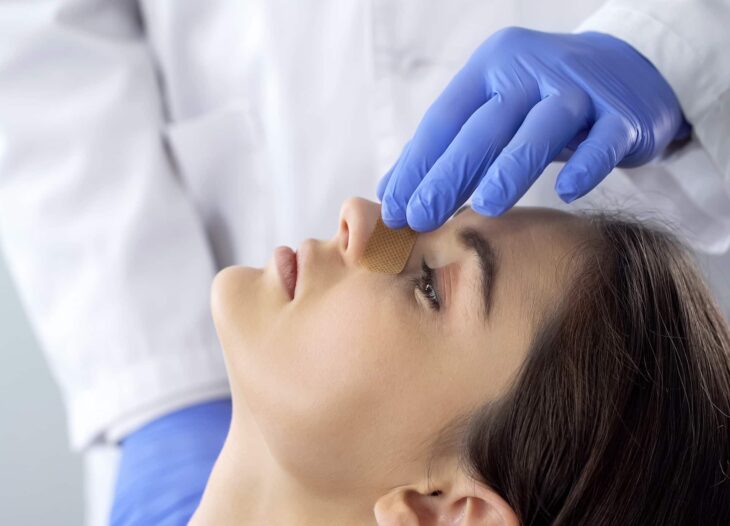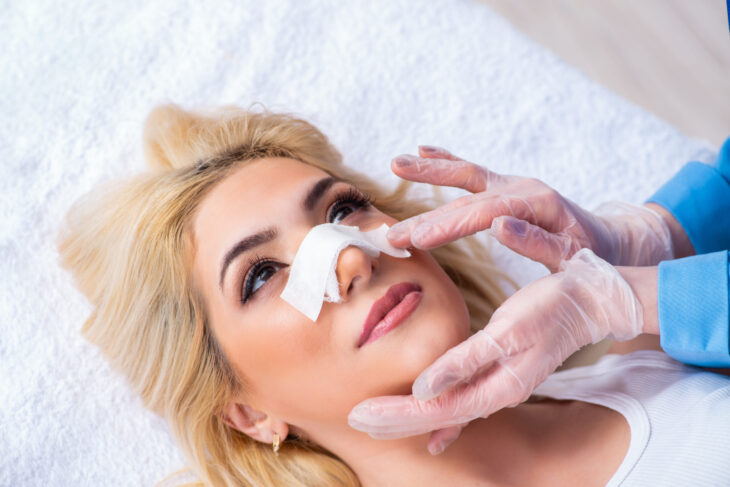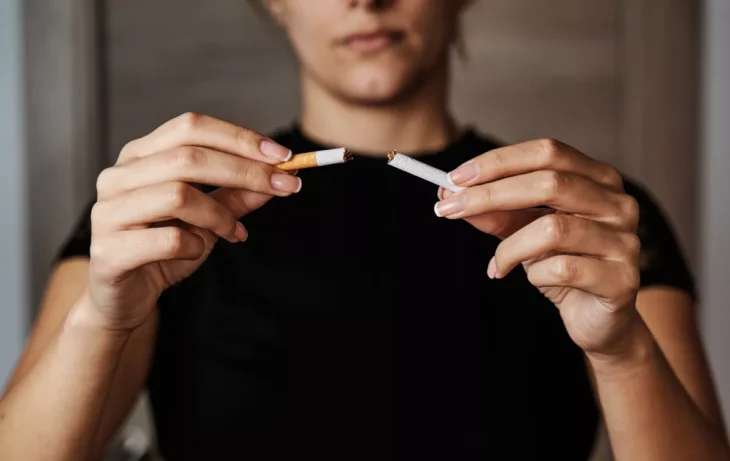Rhinoplasty is also known as a nose job, and this job improves the look of the whole facial appearance by making changes to the nose. This surgery is a prominent option for people who are not happy about their nose’s shapes and sizes. However, like every other surgery, rhinoplasty also takes some recovery time. Here we will discuss the recovery part after the nose job is done.
While the decision to undergo rhinoplasty is a significant one, the journey doesn’t end at the operating table. The recovery phase is a crucial part of the process and one that requires your careful attention. There’s a series of stages to the recovery, all of which vary in duration, from the initial swelling and bruising to the final unveiling of your newly-shaped nose. This period can be a time of anticipation, and understanding what to expect can ease any anxieties. In the following sections, we’ll delve deeper into what the rhinoplasty recovery process entails, arming you with the knowledge to handle this journey with confidence.
Contents
- How Long Is Nose Job Recovery Time?
- Rhinoplasty Recovery Timeline
- 10 Tips To Speed Up The Rhinoplasty Recovery
- 1. Follow The Instructions Of Your Doctor
- 2. Be Aware Of Side Effects
- 3. Keep Your Head Up
- 4. Use Cold Compress To Reduce Swelling
- 5. Maintain a Healthy Diet
- 6. Stay Hydrated
- 7. Gentle Nasal Irrigation
- 8. Do not blow your nose
- 9. Exercise Without Rigorousness
- 10. Stay Away From The Sun
- 11. Avoid Smoke
- 12. Be patient!
- Bottomline
How Long Is Nose Job Recovery Time?
There is no definitive answer to this question. Every individual heals differently, and the amount of time it takes to recover from surgery also depends on the specific surgery performed. In general, however, most people take between two and four weeks to recover from rhinoplasty surgery. Keep in mind complete recovery takes up to 1 year.
During the first few days after surgery, it is common to experience bruising and swelling. Most of this will go down within the first week. It is also common to experience some pain and discomfort during this time. It is essential to follow your doctor’s instructions carefully to ensure a smooth and speedy recovery. Most people find that their energy levels return to normal within two weeks of surgery. Check out iranhealthagency for Rhinoplasty from world’s top surgeons.

Source: Yeniben.com
Rhinoplasty Recovery Timeline
One year is the average recovery time for rhinoplasty. Although it may seem like a lengthy period, it is much easier to manage when you break it down into a timeline. Although the exact recovery milestones will vary from one patient to another, they are generally similar.
1 Week: The splint is easily removed; one can return to work without any visible surgery signs unless there is any bruising. It may take up to 2 weeks for the problem to be resolved. You can resume your daily activities.
2 Weeks: In the second week, you will also feel reduced face swelling and bruising.
3-4 weeks: You can safely return to cardio activities like jogging and swimming.
6 Weeks – Your bones are strong, and you can continue resistance training such as weight lifting, wearing glasses, blowing your nose, and doing other activities.
3-6 Months: You will have an absence of numbness or abnormal nose sensation, nasal skin, and ears.
One year: The healing process has ended. All swelling should have ended completely, and your nose should now be entirely shaped.

Source: RealSelf.com
10 Tips To Speed Up The Rhinoplasty Recovery
Here are the crucial tips that will assist you in your recovery process and help keep it on the go.
1. Follow The Instructions Of Your Doctor
The best advice is to follow the instructions of your doctor and schedule follow-up appointments. Because they are the experts who completed the nose job process and knew about your case thoroughly, your surgeon will help you recover and recommend the proper medications.

Source: perecman.com
2. Be Aware Of Side Effects
You may experience side effects such as redness under your eyes or tiny bruising. It should disappear within two weeks. If it continues long, then do not delay contacting your rhinoplasty surgeon. You may feel some discomfort at first, but this should fade over the next few weeks. You should notify your doctor if you experience severe discomfort or pain that prevents you from returning to your normal activities.
3. Keep Your Head Up
It is essential to keep your head up straight for the first few weeks to prevent injury and blood flow. It suggests that you need to rest in a straight position for six weeks after surgery.

Source: zulianimd.com
4. Use Cold Compress To Reduce Swelling
It is recommended to use a cold compress on your forehead for the first two to three days after surgery to reduce swelling and redness. Do not apply the cold compress directly to your nose. This will cause it to become out of position. Instead, place it on the cheeks and do not touch your nose.
5. Maintain a Healthy Diet
It is essential to eat a healthy and balanced diet while recovering from your nose surgeries. To help reduce swelling and speed up healing, you should eat nutritious meals rich in vitamin C, vitamin D, protein, calcium, as well as anti-inflammatory substances.

Source: health.clevelandclinic.org
6. Stay Hydrated
Adequate hydration plays a critical role in post-operative recovery and it will aid in reduced face swelling and bruising process that occurs after a surgery. Consuming plenty of fluids, particularly water, aids your body’s natural healing processes, including reducing inflammation and swelling. It helps to detoxify the body, flushing out any toxins that may impede recovery. In addition, it keeps your body’s cells, including those at the surgical site, optimally functioning. Remember, it’s not just about drinking when you’re thirsty. Aim for consistent hydration throughout the day.
7. Gentle Nasal Irrigation
This can be a particularly helpful part of your post-operative care routine. Under the guidance of your surgeon, using a gentle saline solution can keep the nasal passages clean, reduce the chances of infection, and minimize swelling. It helps to soothe any dryness or irritation caused by the surgery, promoting a more comfortable healing process. However, it is crucial to follow your surgeon’s specific instructions for this process, as aggressive or incorrect irrigation can potentially harm the healing tissues.
8. Do not blow your nose
Make sure that you do not blow your nose initially, six weeks after your rhinoplasty. In the first six weeks, you will experience lots of congestion from blockages in the nasal passage. Remember not to blow at any cost. Consult your surgeon to discuss using saline nasal sprays to clear the congestion and slime buildup. Also, avoid direct contact with your nose in the initial days after surgery, such as wearing sunglasses, face masks and scratching. A few days of post-surgery are very delicate, and you must care for it carefully; otherwise, you may have a severe injury.
9. Exercise Without Rigorousness
It takes approximately six weeks for your nose bone to heal after surgery, So it is recommended not to do strenuous workouts during this time period. Even seemingly harmless movements, such as lifting or stretching, can cause nasal swelling. Before you get back into your exercise routine, you should wait till the surgeon has permitted you to restart your exercise activities.

Source: pinkvilla.com
10. Stay Away From The Sun
After rhinoplasty, you should avoid your nose from direct exposure to the sun. Your nose will be more susceptible to sunburns in the months following the nose surgery. However, direct sunlight can cause scarring and swelling.
11. Avoid Smoke
It is essential to quit smoking before and after surgery. Tobacco products can reduce blood flow and make it harder for your body to recover from any injury.

Source: newsrnd.com
12. Be patient!
All you need is to have patience. Indeed, you will get the best results from the nose job you desire. It just takes some time. Although these steps will make a year-long process faster, they will improve your experience after surgery.
Bottomline
The recovery process for rhinoplasty may seem complicated at first. Although the recovery process takes six weeks, you can get back to your routine in five to fourteen days. During the final four to five weeks of your recovery, you don’t have much to worry about other than maintaining your blood pressure as steady as possible.
